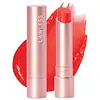Merit Beauty Signature Lip Lightweight Lipstick Versus Lawless Forget The Filler Lip Plumping Line Smoothing Tinted Balm Stick
What's inside
What's inside
 Key Ingredients
Key Ingredients

 Benefits
Benefits

 Concerns
Concerns

 Ingredients Side-by-side
Ingredients Side-by-side

Ricinus Communis Seed Oil
MaskingIsostearyl Isostearate
EmollientCaprylic/Capric Triglyceride
MaskingDimer Dilinoleyl Dimer Dilinoleate
EmollientTribehenin
EmollientC10-18 Triglycerides
EmollientPolyethylene
AbrasiveBis-Diglyceryl Polyacyladipate-2
EmollientHelianthus Annuus Seed Cera
EmollientHelianthus Annuus Seed Wax
Skin ConditioningCopernicia Cerifera Wax
Carica Papaya Fruit Extract
Skin ConditioningHelianthus Annuus Seed Oil
EmollientAscorbyl Palmitate
AntioxidantTocopherol
AntioxidantBeta-Sitosterol
Emulsion StabilisingSqualene
EmollientPhenoxyethanol
PreservativeTropolone
Skin ConditioningAroma
CI 77891
Cosmetic ColorantCI 77491
Cosmetic ColorantCI 77492
Cosmetic ColorantCI 77499
Cosmetic ColorantCI 77742
Cosmetic ColorantCI 42090
Cosmetic ColorantCI 19140
Cosmetic ColorantCI 15850
Cosmetic ColorantRicinus Communis Seed Oil, Isostearyl Isostearate, Caprylic/Capric Triglyceride, Dimer Dilinoleyl Dimer Dilinoleate, Tribehenin, C10-18 Triglycerides, Polyethylene, Bis-Diglyceryl Polyacyladipate-2, Helianthus Annuus Seed Cera, Helianthus Annuus Seed Wax, Copernicia Cerifera Wax, Carica Papaya Fruit Extract, Helianthus Annuus Seed Oil, Ascorbyl Palmitate, Tocopherol, Beta-Sitosterol, Squalene, Phenoxyethanol, Tropolone, Aroma, CI 77891, CI 77491, CI 77492, CI 77499, CI 77742, CI 42090, CI 19140, CI 15850
Dipentaerythrityl Hexahydroxystearate/Hexastearate/Hexarosinate
Skin ConditioningSynthetic Beeswax
Emulsion StabilisingDiisostearyl Malate
EmollientOleic/Linoleic/Linolenic Polyglycerides
EmollientOctyldodecanol
EmollientButyrospermum Parkii Butter
Skin ConditioningSimmondsia Chinensis Seed Oil
EmollientPolyglyceryl-3 Diisostearate
EmulsifyingMicrocrystalline Wax
Emulsion StabilisingHydrogenated Poly(C6-14 Olefin)
EmollientC18-21 Alkane
SolventSimmondsia Chinensis Butter
Skin ConditioningAroma
Ethylhexyl Palmitate
EmollientTocopheryl Nicotinate
AntioxidantJojoba Esters
EmollientMenthoxypropanediol
MaskingHelianthus Annuus Seed Wax
Skin ConditioningTribehenin
EmollientEthylene/Propylene/Styrene Copolymer
Sorbitan Isostearate
EmulsifyingAcacia Decurrens Flower Wax
EmollientPolyglycerin-3
HumectantGlycerin
HumectantWater
Skin ConditioningRosa Canina Fruit Oil
EmollientZingiber Officinale Root Extract
MaskingButylene/Ethylene/Styrene Copolymer
Palmitoyl Tripeptide-1
Skin ConditioningLactic Acid
BufferingPhenoxyethanol
PreservativePentaerythrityl Tetra-Di-T-Butyl Hydroxyhydrocinnamate
AntioxidantTocopherol
AntioxidantCI 73360
Cosmetic ColorantCI 45410
Cosmetic ColorantCI 19140
Cosmetic ColorantDipentaerythrityl Hexahydroxystearate/Hexastearate/Hexarosinate, Synthetic Beeswax, Diisostearyl Malate, Oleic/Linoleic/Linolenic Polyglycerides, Octyldodecanol, Butyrospermum Parkii Butter, Simmondsia Chinensis Seed Oil, Polyglyceryl-3 Diisostearate, Microcrystalline Wax, Hydrogenated Poly(C6-14 Olefin), C18-21 Alkane, Simmondsia Chinensis Butter, Aroma, Ethylhexyl Palmitate, Tocopheryl Nicotinate, Jojoba Esters, Menthoxypropanediol, Helianthus Annuus Seed Wax, Tribehenin, Ethylene/Propylene/Styrene Copolymer, Sorbitan Isostearate, Acacia Decurrens Flower Wax, Polyglycerin-3, Glycerin, Water, Rosa Canina Fruit Oil, Zingiber Officinale Root Extract, Butylene/Ethylene/Styrene Copolymer, Palmitoyl Tripeptide-1, Lactic Acid, Phenoxyethanol, Pentaerythrityl Tetra-Di-T-Butyl Hydroxyhydrocinnamate, Tocopherol, CI 73360, CI 45410, CI 19140
 Reviews
Reviews

Ingredients Explained
These ingredients are found in both products.
Ingredients higher up in an ingredient list are typically present in a larger amount.
Aroma refers to an ingredient, or mixture of ingredients, that impart or mask a flavor.
The name is slightly confusing. This is because INCI associates aroma with flavor instead of smell.
Here is the official definition from the The International Cosmetic Ingredient Dictionary and Handbook:
“Aroma is a term for ingredient labeling used to identify that a product contains a material or combination of materials normally added to a cosmetic to produce or to mask a particular flavor.”
INCI shows the only purpose of aroma to be "flavouring".
However, due to regulation differences, some companies may use aroma in place of parfum.
In Canada, this ingredient only has to be listed in concentrations above 1%.
Learn more about AromaCI 19140 is also known as Tartrazine. Tartrazine is a synthetic dye used in cosmetics, foods, and medicine to add a yellow color.
Tartrazine is created from petroleum and is water-soluble.
Some people may experience allergies from this dye, especially asthmatics and those with an aspirin intolerance.
Learn more about CI 19140Helianthus Annuus Seed Wax is created from the common sunflower.
Sunflower seed wax is made up of long chain non-glyceride esters, a small amount of fatty alcohols, and fatty acids.
This ingredient is often used to enhance the texture of products. The fatty acid properties also help hydrate the skin.
Learn more about Helianthus Annuus Seed WaxPhenoxyethanol is a preservative that has germicide, antimicrobial, and aromatic properties. Studies show that phenoxyethanol can prevent microbial growth. By itself, it has a scent that is similar to that of a rose.
It's often used in formulations along with Caprylyl Glycol to preserve the shelf life of products.
Tocopherol (also known as Vitamin E) is a common antioxidant used to help protect the skin from free-radicals and strengthen the skin barrier. It's also fat soluble - this means our skin is great at absorbing it.
Vitamin E also helps keep your natural skin lipids healthy. Your lipid skin barrier naturally consists of lipids, ceramides, and fatty acids. Vitamin E offers extra protection for your skin’s lipid barrier, keeping your skin healthy and nourished.
Another benefit is a bit of UV protection. Vitamin E helps reduce the damage caused by UVB rays. (It should not replace your sunscreen). Combining it with Vitamin C can decrease sunburned cells and hyperpigmentation after UV exposure.
You might have noticed Vitamin E + C often paired together. This is because it is great at stabilizing Vitamin C. Using the two together helps increase the effectiveness of both ingredients.
There are often claims that Vitamin E can reduce/prevent scarring, but these claims haven't been confirmed by scientific research.
Learn more about TocopherolTribehenin comes from glycerin and behenic acid.
It is used as an emollient, or moisturizer. Emollients form a thin barrier on skin to prevent moisture from escaping.
This ingredient may not be Malassezia folliculitis, or fungal-acne safe.
Learn more about Tribehenin